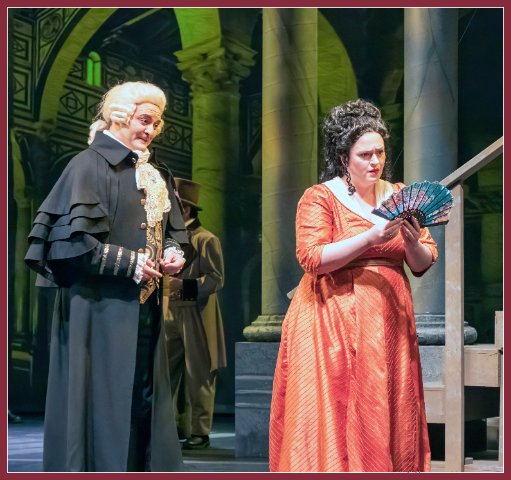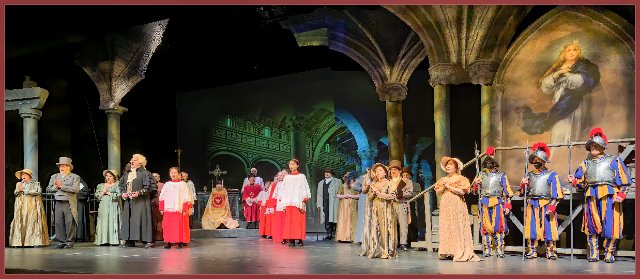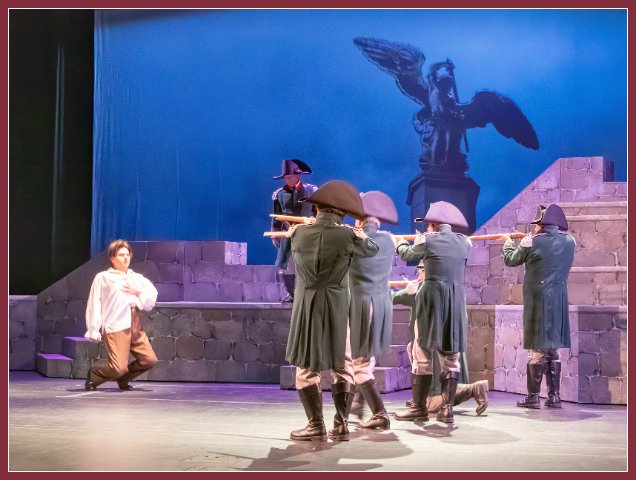Tosca
Livermore Valley Opera's Fine Production of Puccini's Searing Verismo Opera
By: Victor Cordell - Mar 15, 2023
Of all opera composers, perhaps none is so beloved for his soaring lyricism and accessibility as is Giacomo Puccini. His tragic heroines radiate fine-grained distinction. And where is the maestro more embraced than the Bay Area? From the time that Gaetano Merola brought professional opera to San Francisco, no composer has reigned with such a following. All four of Puccini’s top tier of masterworks, “La Bohème” (1896), “Tosca” (1900), “Madama Butterfly” (1904), and “Turandot” (1926) enjoy great popularity here.
The work that stands as the benchmark is the passionate “Tosca,” which audiences can’t get enough of. While sometimes criticized for its harshness, its compelling music which demands great vocal artistry, along with its wrenching libretto make it a perennial favorite. As appealing as “Tosca” is to audiences, its productions attract fine performers. The intense drama possesses three mighty roles to-die-for, and indeed, all three of the characters die!
Livermore Valley Opera provides a handsome, artistic, and well-cast traditional production of “Tosca,” which is no mean feat. In its essence, the opera is an intimate triangle of love, predation, betrayal, and murder. Although Puccini was no stranger to big ensemble numbers, he deliberately restrains that temptation to retain a strong sense of verismo and human closeness.
Yet the intimacy of “Tosca” plays against a grand canvass of three unrelated settings, which LVO executes deftly. Act 1 occurs in the nave of the Church of Sant’Andrea della Valle, where Cavaradossi is painting a larger-than-life portrait of the Magdalene for the church. Significant to the narrative, the painter is also a revolutionary fighting to overthrow Rome’s current government. In this act, the integration of the physical set with the backlit projections is especially well done. Act 2 takes place in the Chief of Police Scarpia’s vast quarters in Palazzo Farnese. Here, he manipulates his defenseless prey, Tosca, with sexual extortion, and Cavaradossi, with false arrest and beating. Act 3 takes place against the parapet of Castl Sant’Angelo, where Cavaradossi faces a firing squad.
Casting for the three main parts in this opera is critical, starting with the title role, and Livermore Valley Opera has attracted Ann Toomey for her Bay Area debut. Toomey offers the vocal versatility that suits this demanding role completely. In mid range and middle volume, her lyrical voice caresses the composer’s beautiful melodic lines. But Tosca is an actress - one who suffers personal degradation and whose lover faces existential threat. As Toomey’s voice crescendos in emotional scenes, it emits a dramatic fervor rising to the intensity of the moment. Although she masters this duality throughout, it particularly comes together in Tosca’s wistful yet powerful signature aria, “Vissi d’arte” (“I lived for art”), when she realizes that life will not go on as before, and she begs Scarpia to release her from the pain.
Although Alex Boyer’s resumé includes stints around the country, he is well planted in the Bay Area, where he has become an audience favorite as a fine lyric tenor with a strong, clear, and compelling voice. Cavaradossi fits well within his catalog. He nails the hero’s bookend arias. His romanza, “Recondita armonia” (“Concealed harmony”), a love letter to Tosca when life is good, is sung with great panache. Sadly, he faces death and regret with the hauntingly delivered “E lucevan le stelle” (“The stars showed brightly”), though his being seated at the beginning of the latter reduces the impact at the start of the piece. Boyer also brings a little bit extra to his portrayal. Cavaradossi is often played with a rather dull earnestness, but the tenor adds a light and humorous touch with a charming twinkle in the eye.
It is unsurprising to learn that, despite his youth, Aleksey Bogdanov has performed Scarpia with several opera companies around the country. His characterization is as well-matched as it is profound. The high demand for his services in this part becomes evident from his first entry onto the stage. Unctuously pursuing Tosca, this cruel and imposing figure is a visual magnet who dominates the stage. More importantly, Bogdanov’s dark baritone booms, but with a percussive clarity unusual for such deep tones. While sopranos are often asked to sing above the din of many voices, it is uncommon to expect a male with a lower voice to do so. But Bogdanov rises to the occasion with his “Va, Tosca / Te Deum” in which he vocally slays the lesser voices surrounding him. The resounding number is particularly poignant in contrasting Scarpia’s purported religious devotion with his lust for Tosca as he repeats her name against the religiously themed music.
Of the supporting roles, Kirk Eichelberger deserves special recognition. In his brief presence as Angelotti, an escaped prisoner and political ally of Cavaradossi, he delivers a ringing vocal account with his nimble baritone voice. Conductor Alexander Katsman paces the orchestra well and produces a mellow sound. One of the understandable compromises that a smaller opera company must make is the size of the orchestra. Underpowering is an occasional issue, particularly with the striking opening of the opera and other recurrences of the searing Scarpia motif. Nonetheless, “Tosca” is another credit to LVO’s artistry.
“Tosca,” composed by Giacomo Puccini, with libretto by Luigi Illica and Giuseppe Giacosa, is produced by Livermore Valley Opera and plays at Bankhead Theater, 2400 First Street, Livermore, CA through March 12, 2023.





